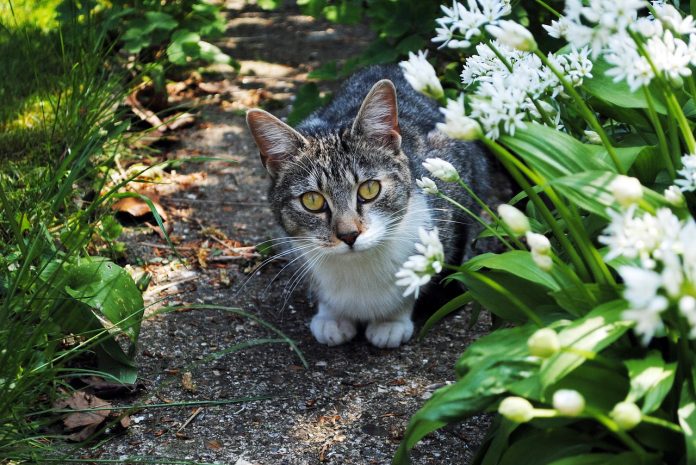Petscaping can help you achieve the curb appeal you’ve been wanting, while still keeping your yard inviting to your pets. Petscaping encourages your animals to enjoy spaces created just for them, reducing potential damage to your gardens and lawn. You can learn how to create a space that is both appealing and safe for your pets by using the tips listed below.
Designing a pet-friendly backyard
Successful petscaping starts with a design that incorporates both areas for your pets and areas for your gardens. A good design includes boundaries, shade, access to fresh water, a potty area and, for dogs, a place to run and play.
Paths. Before you start planning how you’ll design your yard with your pet in mind, it’s important to take notice of favorite areas and routes. By incorporating them into your design, you’re eliminating some of the retraining required for a well-planned petscape to work. Pathways are a good way to help your pet distinguish where it should and shouldn’t be. Make your pet’s favorite route part of your design by turning it into a pathway in your design. Use smooth gravel or flagstones and avoid anything sharp.
Exercise area. If you’re a dog owner, you should plan an area designated for exercise. Dogs are less likely to invade flower beds and vegetable gardens when they have their own space to run and play.
Dig pit. Dogs enjoy digging, but it can be hard on a yard and gardens. By adding a digging pit, you’re providing a space where your dog can dig without uprooting any flowers or turf. To create a dig pit, dig out a designated area, fill it with sand and burry toys, bones or treats in the sand. When your dog visits the pit, praise it for digging in the special area to encourage continued use.
Potty area. There’s no doubt pets potting in the yard and garden can cause damage. Creating a designated area for dogs can eliminate widespread damage to your lawn. Likewise, making a sandbox for your cat can deter it from using your flower beds. To attract your cat to the new potty area, surround it with catnip, lemongrass and valerian.
Boundaries. Using short fences or borders to show parameters can help dogs recognize which areas of the yard are off limits. Constructing these boundaries out of the same material will make it even easier for your dog to recognize. Another option is using raised beds for planting areas. However, if you already have perimeter fencing around your yard and your dog likes to patrol, make sure to leave a few feet between that fencing and any raised beds you decide to install.
Densely planted areas. You can also use densely planted areas to protect delicate plants, shielding them with hardy shrubs and perennials.
Shade and water. Pets, dogs especially, are sensitive to heat and need protection from the sun, as well as, access to water. Before you finish petscaping your yard, make sure to include these elements.
Safety considerations
Once you’ve designed your petscape to include your pet’s favorite paths and elements of interest, you need to take safety into consideration before you start gardening.
Toxic plants. Selecting nontoxic plants prevents your pet from any accidental exposure. Some common garden plants that are toxic to dogs and/or cats include azaleas, lilies rhododendrons, yew, autumn crocus and English ivy. Daffodil and tulip bulbs can also pose a threat. For a complete list, visit the American Society for the Prevention of Cruelty to Animals (ASPCA) website. In addition to choosing nontoxic plants for new landscaping, make sure to check that you don’t have any toxic varieties already growing, including wild plants and mushrooms.
Plants with thorns. If you have plants with thorns growing in your garden, beware of thorns on the soft pads of your pet’s feet, as well as, the potential for eye injuries.
Mulch. Did you know cocoa mulch contains the same ingredient that makes chocolate toxic to your dog? Well, you do now. Your best bet is to choose natural wood chips to avoid sensitivities to colors and dyes.
Compost. Make sure your compost bin is secure, so your pets don’t have access. Eating old food can make them sick.
Fertilizers, herbicides and insecticides. Always be careful when storing or using insecticides, herbicides and fertilizers around pets. Make sure they are stored properly so your pet doesn’t have access. When you do have to apply any of these to your yard or garden, read the label carefully to make sure your pets are kept out of the garden for enough time after using them.
Pests. Ticks, mosquitoes and fleas are common pests that pet owners have to contend with every year. Warmer temperatures and increased rainfall have made their populations explode in recent years. To combat these pests, first and foremost, make sure to use flea, tick and heartworm preventative as prescribed by your veterinarian. To reduce populations of these harmful insects in your yard, you should remove leaf litter, mow and conduct mosquito checks regularly.












